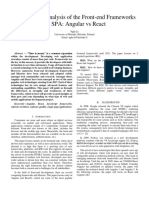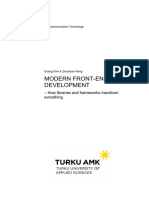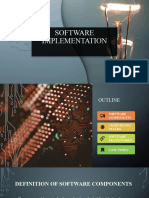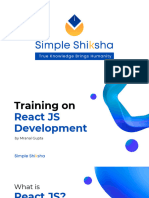© University Press 2023 “Journal of Education, Technology and Computer Science”
ISSN 2719-6550 No. 4(34)/2023
ISSN 2719-7417 online www.eti.ur.edu.pl
Received: 15.09.2023 DOI: 10.15584/jetacomps.2023.4.21
Accepted for printing: 15.12.23
Published: 29.12.2023
License: CC BY-SA 4.0
PAWEŁ DYMORA 1, MIROSŁAW MAZUREK 2
,
MARIUSZ NYCZ 3
Comparison of Angular, React, and Vue Technologies
in the Process of Creating Web Applications
on the User Interface Side
1 ORCID: 0000-0002-4473-823X, Ph.D. Eng., Rzeszów University of Technology, Faculty of
Electrical, and Computer Engineering, Department of Complex Systems, Poland
2 ORCID: 0000-0002-4366-1701, Ph.D. Eng., Rzeszów University of Technology, Faculty of
Electrical, and Computer Engineering, Department of Complex Systems, Poland
3 ORCID: 0000-0002-6297-5730, Ph.D. Eng., Rzeszów University of Technology, Faculty of
Electrical, and Computer Engineering, Department of Complex Systems, Poland
Abstract
This paper presents a comparative analysis of three programming technologies and their ap-
plication in building a web application, taking into account the code on the server-side and the user
interface side. Three equivalent applications Angular, Vue, and React were analyzed. The needs
for web applications are described, the implementation of particular functionalities in all technolo-
gies is presented together with the programming of database functionalities. The article is aimed at
helping students of computer science faculties to make an informed choice of a framework or
library for a specific project, taking into account the differences between these popular solutions.
Keywords: WEB applications, design process
Introduction
A WEB application is an interactive program that runs on a server accessi-
ble from any browser. To use a web application you don’t need to install any-
thing, but you do need a browser and access to the Internet. Continuous deve-
lopment of web technologies has made the applications less and less scalable,
therefore developers found it useful to separate the front-end and back-end of the
application (Molina-Ríos, Pedreira-Souto, 2020; Technical Documentation in
Software Development: Types and Best Practices, 2; Kaluža, Vukelić, 2018).
210
�The first part is responsible for what the user sees, it makes up the visible inter-
face, while the second part is responsible for the layer that is invisible to the
user, it is responsible for the operation of the site from the “inside”. The server
part communicates with the interface part and is responsible for the functionali-
ties. With each user action, the browser sends a request to the server which re-
turns information in the form of client layer code. In turn, the browser interprets
the code and displays it in a user-friendly form (Kaluža, Vukelić, 2018; Current
browser market share, 2021; Dymora, Paszkiewicz, 2020).
The main tools without which the compilation of script code into an actual
page would not succeed are browser engines. They are used to render web pages,
mainly used by web browsers. It is software that is responsible for processing
the content of web pages and their formatting elements and then rendering them
in a user-friendly manner . On the user interface side, there are three main types
of technologies: HTML, CSS, JavaScript. On the server-side of the application,
the database system can be separated – this is the place where data is stored. The
programmer defines their structure and describes them. The most popular data-
bases are MySQL, PostgreSQL, Firebird (Current browser market share, 2021;
Dymora, Paszkiewicz, 2020; Dymora, Mazurek, Mroczka, 2021; https://www.post-
gresql.org/; https://firebirdsql.org/). The programming language used is i m-
portant. The server-side programmer has a choice of many programming lan-
guages, and the most popular are Python, Java, C#. In Java, servlets can be
distinguished as a basic element of business applications, they are used both
in Java EE applications and those developed in Spring MVC. The most com-
plex applications nowadays also need highly developed tools, so the article
focuses on comparing the three most popular solutions: Angular, Vue, React
(Dymora, Paszkiewicz, 2020; Flanagan, 2021; https://www.javascript.com/;
Freeman, 2018).
This paper presents a simplified methodology and description of the applica-
tion development process. The presented approach shows in detail what stages
the entire web application development process consists of and what influences
its efficiency. The presented cycle of creation of a new IT product allows one to
properly understand the project process, as the knowledge gained is crucial from
the business point of view of the work on a given IT project. In particular, nov-
ice developers as well as IT students can compare the essential properties of
popular web application programming technologies and use the corresponding
one in the process of web application development. This is achievable through
a rather in-depth comparison of Angular, React, and Vue technologies in the
process of creating web applications on the user interface side.
The paper is divided into five sections. The introduction provides a review
of the literature and recent trends in technologies used in the development of
211
�user interfaces in web-based applications. Chapter two characterizes the test envi-
ronment and methods selected for the study. Chapter three presents selected
research technologies used and their main characteristics. Chapter four presents
a description of the experiments and a comparative analysis of the results ob-
tained. Summary, conclusion, and scope of future research are presented in
Chapter five.
Test application design
In order to make an objective comparison of the discussed technologies,
a web application “Car Seller” was designed. The main function of the applica-
tion is to enable the user to buy a car in an online car shop. Each user, to use the
store, has to register. After registration, the user can choose from over 1700 cars,
a model that interests him. The data about the cars, such as price and condition,
are selected according to a proprietary algorithm based data on from an open
API. The user can filter the cars by 3 features. After selecting cars or a car, the
user is able to add it to his/her cart and then purchase it. The data from the pur-
chase is stored in the Firebase database. The structure of the application is
shown in Figure 1.
Script code - JavaScript,
Type Script (Angular,
Vue, React)
CSS, SCSS, Styled
Components
HTML 5
Firebase Application
Internet User browser
Server
Figure 1. Structure of the application “Car Seller”
Description of selected technologies
Three applications identical in terms of functionality were prepared for test-
ing using different technologies and programming environments. The detailed
implementation is shown in Table 1.
212
�Table 1. Summary of implementation details of developed applications and used technologies
Application #1 Application #2 Application #3
Script Language TypeScript JavaScript JavaScript
Technology Angular React Vue
Styled Components
Page Styles Pre-processor SCSS CSS
Library
Used environment PHP Storm Visual Studio Code Visual Studio Code
Hypertext Markup
HTML 5 HTML 5 HTML 5
Language
JavaScript Language
The JavaScript language is a dynamically typed, high-level programming lan-
guage. It is most commonly used for web programming where it provides interac-
tivity and event handling. This language has many libraries that make it easier to
work with one of the first was the jQuery library. This language has gained enor-
mous popularity, especially among web developers on the user interface side, but
this language is also used on the server-side. An environment that helps you run
JavaScript code directly on your computer without any browser involvement is
Node.js. According to the Tiobe index, the language is ranked as the seventh most
popular language (Flanagan, 2021; https://www.javascript.com/).
Angular programming technology
Angular is a comprehensive development tool for creating SPA (Single Page
Ap-plication) applications that are loaded dynamically in the browser. This tech-
nology does not need to download the page from the server the user goes through
the individual tabs. Angular has been developed by the Google team and commu-
nity and is an open-source project. Angular as technology provides all the tools to
create a SPA, it does not need to download other libraries like HTTP library which
other technologies need. Angular is fully written in TypeScript which allows for
greater scalability of any project (Freeman, 2018; https://angular.io/features).
React programming technology
React is a JavaScript programming language library that is used to create
user interfaces for various types of applications and is available to the general
public because it is open-source. React was created by one of Facebook employees
Jordan Walke. The React library, like Angular, allows you to create interactive
SPA-type pages. React by itself does not provide all the tools you need to create
SPA-type applications, many additional features need to be downloaded, but
when a developer plans to make a smaller application and cares about its
smaller size it can be considered a plus. An additional advantage that can be
given to React is the documentation in Polish (https://pl.reactjs.org/; Chin-
nathambi, 2019).
213
�Comparative analysis of study results
Depending on the technology, components are written in different ways. In
an application written in Angular technology one component is contained in
three files: CSS, HTML, TypeScript. When components written in React and
Vue technologies are contained in a single file, in React technology these are
files with .js extensions, in turn, components written in Vue technology are
components with .vue extension (Hanchett i Listwon, 2020). In each application
one file is responsible for configuration settings, in each of them it is a package.json
file. It contains, among others, information on how to run the application, the
version number of the application, or installed dependencies. Additionally, in an
application written in Angular technology, there is an angular.json file that has
information about the configuration of Angular CLI which makes it easier for
the developer to develop the application. An overview of the application struc-
tures can be seen in Figure 2.
Figure 2. File and directory structure of the application written in three technologies:
Angular (left), Vue, React (right)
214
� An identical mechanism for adding cars to the list was used in the three ap-
plications. It was implemented differently depending on the application, but the
algorithm works the same way. The data to be processed in the application was
taken from an open API. They were created in 1997. There are 1728 rows of
data in 7 columns in the downloaded data.
The comparison scenario involved listing each component in each applica-
tion, listing selected parts of the implementation, and then comparing compo-
nents written in three different technologies and development tools. The applica-
tion is written in Angular technology used: TypeScript scripting language, SCSS
Preprocessor in page styling. It was written in the PHPStorm environment. It
used HTML 5 as a hypertext markup language.
The next application written in React technology used JavaScript scripting
language, Styled Component library in page styling, Visual Studio Code envi-
ronment, HTML 5. The last application written used Vue technology and also
used JavaScript scripting language, CSS for page styling, and Visual Studio
Code and HTML5.
The comparison scenario also included a list of runtimes for each compo-
nent in the applications, as well as the time period needed to write a given com-
ponent and the number of lines of code needed to implement a given functionali-
ty separately for the code responsible for the hypertext markup language, the
code responsible for the scripting language, and the code responsible for view
styling. The rendering time studies for a given component will be recalculated
thanks to the add-ons: Vue Devtools for an application written in Vue, React
Developer Tools for an application written in React, and Angular DevTools for
an application written in Angular.
Comparison of login function implementations
The codes responsible for hypertext markup languages differed very little. In
React technology, after using the Styled Component library, each component
that was styled separately was assigned to JavaScript const variables. Compo-
nents written in Vue and Angular technologies were tagged with ordinary
HTML code tags, which can be seen in Figure 3.
215
� Figure 3. HTML code of applications written in Angular, Vue and React
216
� As we can see in Figure 4, most codes appeared in the application written in
Vue technology.
Figure 4. The number of code lines (left) and code characters count (right) responsible
for HTML
Cascading Style Sheets Implementation
The technique for styling the view responsible for logging in all three appli-
cations differed. In the application written in Vue technology, the styling was
contained in .css files. When styling in Angular, the application was supported
by SCSS preprocessor. On the other hand, the styling of elements in the React
application differed the most from the others. In this case, the styled-components
library was used. In this library, each element that was styled had a separate
entity and was separately assigned to a variable. Sample style codes are shown
in Figure 5.
Figure 5. Comparison of the number of code lines (left) and code characters count (right)
responsible for styling
217
�Script Language
In the application written in Angular technology, Typescript was the scrip-
ting language, while in the Vue and React applications, Javascript was the scrip-
ting language. Figure 6 illustrates that most codes appeared in the application
written in Angular technology. On the other hand, the script code of the applica-
tion written in Vue technology had the most lines.
Figure 6. Comparison of the number of code lines (left) and code characters count (right) in
the script language
The time required to create a given component
Due to the different types of language, a different amount of time is needed
for software development. The calculation of programming time is not reliable,
however, it was observed that it did not take long to write each component. The
first component written in Angular technology took by far the longest due to the
fact that TypeScript language was used. The comparison of workloads is shown
in Figure 7.
Figure 7. The time required to write the login component in three applications
218
�Comparison of browser login component creation time
The next test analyzed the time it takes to create a component in a browser.
Each browser has different rendering times, but the browser used for testing was
Chrome, which has the most facilities for a web developer. In Figures 8 and 9,
you can see that the component created in Vue technology took the longest time
to create.
Figure 8. Rendering times of individual components in React, Vue, Angular applications
in add-ons installed in Google Chrome
Figure 9. The time required for the browser to generate the components
219
�A comparative analysis of the entire application
The overall results of the tests are shown in Table 2. The time needed to
compile each application, as well as the number of lines of code and characters
were analyzed in turn. In the time analysis test, the Windows stopwatch was
started after running the command responsible for compiling the application (for
the Vue application npm run serve, for the React application npm start, for the
Angular application ng serve).
The time required to compile the React application was 15 seconds, in Vue
similarly 12 seconds. The longest application was compiled in Angular (25 se-
conds). The total number of lines of code in each application, as well as the total
number of characters in each application depending on the HTML code, code
responsible for styling and scripting code in each component, showed that Angu-
lar is the most demanding. The lowest values were obtained for React. The com-
piled sums of the number responsible for the script code in applications showed
that the number of lines of script code in all cases was close to 600, and the
number of script characters, as before, was the highest for Angular.
Table 2. Comparison of key application features
React Vue Angular
Complication time [s] 15 12 25
Number of code lines in HTML 150 213 216
Characters number in HTML 6430 7843 9218
Number of code lines in CSS 585 537 545
Characters number in CSS 10122 10416 10758
Number of code lines in the script language 566 619 600
Characters number in the script language 17421 15487 19075
Conclusion
This paper provides a detailed comparative analysis of the most popular
techniques and technologies used in programming web applications on the user
interface side. Three applications written specifically for testing in Angular,
Vue, and React technologies were used to compare the tools. In addition to the
various scripting language technologies, JavaScript and TypeScript were used in
the applications. Styling in the applications was implemented in different ways.
SCSS preprocessor, ordinary CSS, and styled-components library were used.
Applications using different technologies had the same functions. The compari-
sons showed that most of the markup language code appeared in the application
written in Angular technology.
In the case of styling the application, most codes appeared in React techno-
logy. Influence on this definitely had to use the library Styled-Component,
which makes that each element that we want to style should be assigned to
a variable. This solution makes the code definitely more, but it is more scalable
and easier to develop. Using SCSS preprocessor in the application written in
220
�Angular technology made the code the least. You can feel that by doing so the
code is the least readable, but the syntax of the preprocessor promotes intuitive-
ness and scalability of the code.
Analysis of the amount of code responsible for the scripting language
showed that the most appeared in the application written in React. However, if
the .ts files responsible for the service interfaces or “pips” were added to the
scripting code of all the components in Angular, by far the most scripting code
appears in Angular. This technology favors scalability, for example, the user
may be forced to specify the type of a newly defined variable or the type of the
returned element from a function. This situation is conducive to the development
of projects with greater complexity and on which more developers work.
The analysis of the time needed to implement particular components showed
interesting results. The Angular application took the most time, which was due
to the fact that it was the first application that was written, a lot of functionality
had to be designed, and the complexity of the technology, resulted from the need
to use a TypeScript scripting language, which differs from JavaScript. To sum
up, the application written in Angular technology turned out to be the most com-
plex and time-consuming, so definitely this type of technology has the highest
thresh-old of entry for young developers. The application written in Vue took
second place. It took relatively the least time to implement an application written
in React. The complexity of this application is also the lowest, as evidenced by
the amount of code that is written intuitively.
The functionality of the application was chosen because currently
e-commerce applications are by far the most developed in the Polish market.
A great advantage of such applications is the ability to implement additional
elements such as product details and the implementation of a more complex user
page. By far the most needed functionality in applications is the mobile view.
The application can be further developed and, most importantly, it has met the
user’s expectations.
References
(2, 12 2021). Retrieved from: https://distantjob.com/blog/web-application-framework (15.08.2021).
Chinnathambi, K. (2019). React I Redux. Praktyczne tworzenie aplikacji WWW. Gliwice: Helion.
Current browser market share (2021). StatCounter.
Dymora, P., Mazurek, M., Mroczka, B. (2017). VII Konferencja Naukowa “Symbioza Techniki
i Informatyki”. Code optimization of advanced applications on the example of selected deve-
lopment technologies.
Dymora, P., Paszkiewicz, A. (2020). Performance Analysis of Selected Programming Languages
in the Context of Supporting Decision-Making Processes for Industry 4.0. Applied Sciences,
10(23), 8521. doi:10.3390/app10238521.
Flanagan, D. (2021). JavaScript. Przewodnik. Poznaj język mistrzów programowania. Gliwice:
Helion.
Freeman, A. (2018). Angular. Profesjonalne techniki programowania. Gliwice: Helion.
221
�Hanchett, E., Listwon, B. (2020). Vue.js w akcji. Gliwice: Helion.
https://angular.io/features (26.09.2021).
https://firebirdsql.org/ (27.10.2021).
https://pl.reactjs.org/ (21.10.2021).
https://www.javascript.com/ (29.10.2021).
https://www.mysql.com/ (29.10.2021).
https://www.postgresql.org/ (29.10.2021).
Kaluža, M., Vukelić, B. (2018). Comparison front-end frameworks for web applications develop-
ment. Zbornik Veleučilišta u Rijeci, 1. doi:10.31784/zvr.6.1.19.
Molina-Ríos, J., Pedreira-Souto, N. (2020). Comparison of development methodologies in web
applications. Information and Software Technology, 119. doi:https://doi.org/10.1016/j.infsof.
2019.106238.
222



























































































